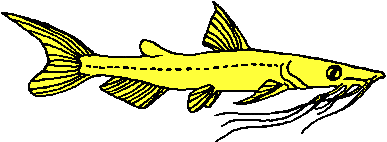 | |
| Pronounced | Pim ee LOW did day |
| Family Common Name | Long-Whiskered or Antennae Catfishes |
| Etymology | pimele, fat; –odes, having the form of, i.e., fatty, referring to their adipose fins (at the time, this was a catch-all family for many species, most of which possess a “fatty” or adipose fin). |
| Features | Naked flanks and generally long barbels. No nasal barbels. |
| Common Names | Pim, Shovelnose |
| Size | Smallest 110mm, largest 3600mm, average 800mm, most commonly 600mm. All SL. |
| Species | There are 49 "species" in 42 genera in the database |
| Keepers | 49 species (100%) are being kept by registered keepers |
| Distribution | South America Login to view the map. |
| 1. | Calophysus | 1 species | (25 keepers) |
| 2. | Platystomatichthys | 1 species | (23 keepers) |
| 3. | Sorubimichthys | 1 species | (16 keepers) |
| 4. | Platynematichthys | 1 species | (12 keepers) |
| 5. | Zungaro | 2 species | (10 keepers) |
(Alphabetic | Chronological | Most Bred) | ||
|---|---|---|
| 1. | (i:18, k:252, b:0) | |
| 2. | (i:26, k:88, b:0) | |
| 3. | (i:17, k:65, b:0) | |
| 4. | (i:17, k:62, b:0) | |
| 5. | (i:12, k:58, b:0) | |
| 6. | (i:15, k:51, b:0) | |
| 7. | (i:24, k:45, b:0) | |
| 8. | (i:22, k:34, b:0) | |
| 9. | (i:21, k:30, b:0) | |
| 10. | (i:7, k:28, b:0) | |
| 11. | (i:10, k:26, b:0) | |
| 12. | (i:26, k:25, b:0) | |
| 13. | (i:17, k:23, b:0) | |
| 14. | (i:10, k:20, b:0) | |
| 15. | (i:14, k:18, b:0) | |
| 16. | (i:2, k:16, b:0) | |
| 17. | (i:13, k:16, b:0) | |
| 18. | (i:11, k:12, b:0) | |
| 19. | (i:13, k:12, b:0) | |
| 20. | (i:18, k:11, b:0) | |
| 21. | (i:7, k:11, b:0) | |
| 22. | (i:10, k:10, b:0) | |
| 23. | (i:14, k:9, b:0) | |
| 24. | (i:5, k:8, b:0) | |
| 25. | (i:10, k:8, b:0) | |
| 26. | (i:10, k:7, b:0) | |
| 27. | (i:10, k:7, b:0) | |
| 28. | (i:8, k:7, b:0) | |
| 29. | (i:11, k:6, b:0) | |
| 30. | (i:9, k:5, b:0) | |
| 31. | (i:9, k:5, b:0) | |
| 32. | (i:5, k:4, b:0) | |
| 33. | (i:2, k:4, b:0) | |
| 34. | (i:2, k:4, b:0) | |
| 35. | (i:10, k:4, b:0) | |
| 36. | (i:4, k:4, b:0) | |
| 37. | Leiarius longibarbis | (i:0, k:3, b:0) |
| 38. | (i:7, k:3, b:0) | |
| 39. | (i:1, k:2, b:0) | |
| 40. | (i:2, k:2, b:0) | |
| 41. | (i:4, k:2, b:0) | |
| 42. | (i:6, k:2, b:0) | |
| 43. | (i:4, k:2, b:0) | |
| 44. | (i:2, k:2, b:0) | |
| 45. | (i:2, k:1, b:0) | |
| 46. | (i:4, k:1, b:0) | |
| 47. | (i:3, k:1, b:0) | |
| 48. | Platysilurus malarmo | (i:0, k:1, b:0) |
| 49. | (i:14, k:1, b:0) | |





/siluriformes/pimelodidae/pimelodus/pictus/1.jpg)
/siluriformes/pimelodidae/phractocephalus/hemioliopterus/1.jpg)
/siluriformes/pimelodidae/pseudoplatystoma/tigrinum/1.jpg)
/siluriformes/pimelodidae/sorubim/lima/1.jpg)
/siluriformes/pimelodidae/leiarius/marmoratus/1.jpg)
/siluriformes/pimelodidae/pimelodus/blochii/1.jpg)
/siluriformes/pimelodidae/brachyplatystoma/tigrinum/1.jpg)
/siluriformes/pimelodidae/brachyplatystoma/juruense/1.jpg)
/siluriformes/pimelodidae/pimelodus/ornatus/1.jpg)
/siluriformes/pimelodidae/phractocephalus/sp_hybrid%281%29/1.jpg)
/siluriformes/pimelodidae/pseudoplatystoma/fasciatum/1.jpg)
/siluriformes/pimelodidae/calophysus/macropterus/1.jpg)
/siluriformes/pimelodidae/platystomatichthys/sturio/1.jpg)
/siluriformes/pimelodidae/leiarius/pictus/1.jpg)
/siluriformes/pimelodidae/brachyplatystoma/filamentosum/1.jpg)
/siluriformes/pimelodidae/sorubimichthys/planiceps/1.jpg)
/siluriformes/pimelodidae/pimelodus/albofasciatus/1.jpg)
/siluriformes/pimelodidae/platynematichthys/notatus/1.jpg)
/siluriformes/pimelodidae/brachyplatystoma/platynema/1.jpg)
/siluriformes/pimelodidae/pseudoplatystoma/corruscans/1.jpg)
/siluriformes/pimelodidae/aguarunichthys/torosus/1.jpg)
/siluriformes/pimelodidae/zungaro/zungaro/1.jpg)
/siluriformes/pimelodidae/platysilurus/mucosus/1.jpg)
/siluriformes/pimelodidae/pimelodus/maculatus/1.jpg)
/siluriformes/pimelodidae/leiarius/perruno/1.jpg)
/siluriformes/pimelodidae/brachyplatystoma/capapretum/1.jpg)
/siluriformes/pimelodidae/brachyplatystoma/rousseauxii/1.jpg)
/siluriformes/pimelodidae/megalonema/platycephalum/1.jpg)
/siluriformes/pimelodidae/hemisorubim/platyrhynchos/1.jpg)
/siluriformes/pimelodidae/brachyplatystoma/vaillantii/1.jpg)
/siluriformes/pimelodidae/luciopimelodus/pati/1.jpg)
/siluriformes/pimelodidae/parapimelodus/valenciennis/1.jpg)
/siluriformes/pimelodidae/phractocephalus/sp_hybrid%282%29/1.jpg)
/siluriformes/pimelodidae/phractocephalus/sp_hybrid%283%29/1.jpg)
/siluriformes/pimelodidae/pimelodus/albicans/1.jpg)
/siluriformes/pimelodidae/pimelodus/tetramerus/1.jpg)
/siluriformes/pimelodidae/pinirampus/pirinampu/1.jpg)
/siluriformes/pimelodidae/megalonema/platanum/1.jpg)
/siluriformes/pimelodidae/pseudoplatystoma/orinocoense/1.jpg)
/siluriformes/pimelodidae/pseudoplatystoma/sp_hybrid%282%29/1.jpg)
/siluriformes/pimelodidae/pseudoplatystoma/sp_hybrid%284%29/1.jpg)
/siluriformes/pimelodidae/sorubim/cuspicaudus/1.jpg)
/siluriformes/pimelodidae/sorubim/elongatus/1.jpg)
/siluriformes/pimelodidae/aguarunichthys/cf_tocantinsensis/1.jpg)
/siluriformes/pimelodidae/conorhynchos/conirostris/1.jpg)
/siluriformes/pimelodidae/pimelodina/flavipinnis/1.jpg)
/siluriformes/pimelodidae/pseudoplatystoma/reticulatum/1.jpg)